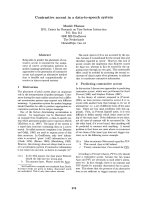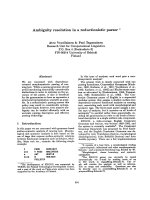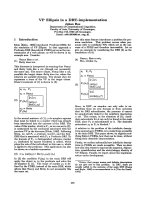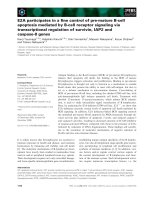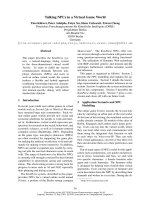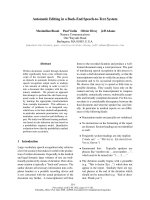báo cáo khoa học: "Jeannine BOSCHER in a hypoprolific boar" pptx
Bạn đang xem bản rút gọn của tài liệu. Xem và tải ngay bản đầy đủ của tài liệu tại đây (429.42 KB, 8 trang )
A
new
reciprocal
translocation
in
a
hypoprolific
boar
C.P.
POPESCU
Jeannine
BOSCHER
LN.R.A.,
Laboratoire
de
Cytogénétique
Centre
National
de
Recherches
Zootechniques,
F
78350
Jouy-en-Josas
LE
HENAFF
H.
JOUET
LN.R.A.,
Station
de
Génétique
quantitative
et
appliquée
C.N.R.Z.,
F
78350
Jouy-en-Josas
Summary
In
France,
boars
are
classified
by
the
National
Program
for
Sow
Herd
Management,
according
to
the
size
of
the
litters
produced.
All
boars
with
an
average
of
less
than
8
live-born
piglets,
from
at
least
6
litters,
are
cytogenetically
examined.
Since
1979,
three
different
reciprocal
translocations
have
been
identified
by
our
laboratory
in
the
hypoprolific
group.
A
new
fourth
reciprocal
translocation,
not
hitherto
described,
has
just
been
found.
The
carrier
Landrace
boar
had
produced
an
average
7.2 ± 2.65
piglets
in
24
litters,
i.e.
a
31.23
p.
100
reduction
of
prolificacy.
This
animal
is
carrying
a
new
reciprocal
translocation
involving
the
small
acrocentrics,
nb.
16
and
17.
The
animal
production
and
economic
consequences
of
the
chromosomal
abnormalities
are
discussed.
Key
words :
Pig,
hypoprolific,
reciprocal
translocation.
Résumé
Une
nouvelle
translocation
réciproque
chez
lui
verrat
hypoprolifique
En
France,
les
verrats
sont
classés
par
le
Programme
National
de
Gestion
Technique
selon
la
taille
des
portées
qu’ils
produisent.
Tous
les
verrats
produisant
en
moyenne
8
por-
celets
par
portée
ou
moins,
sur
un
minimum
de
6
portées,
sont
étudiés
du
point
de
vue
cytogénétique.
Ainsi,
depuis
1979,
trois
translocations
réciproques
différentes
ont
été
identifiées.
Une
nouvelle
translocation,
impliquant
les
chromosomes
16
et
17
est
décrite
chez
un
verrat
Landrace
qui produit
7,2 ±
2,65
porcelets
en
moyenne
sur
24
portées.
La
réduction
de
la
prolificité
de
cet
animal
est
de
31,23
p.
100.
Les
conséquences
des
anomalies
chromosomiques
pour
l’élevage
sont
discutées.
Mots
clés :
Porc,
hypoprolifique,
translocation
réciproque.
(1)
Presented
at
the
4th
American
Symposium
on
Cytogenetics
of
Domestic
Animals.
June
9-12,
1985.
University
of
Illinois,
Urbana,
U.S.A.
I.
Introduction
Chromosomal
structural
abnormalities
in
man
and
animals
may
cause
reproductive
disorders.
The
most
frequent
chromosomal
abnormalities
connected
with
repro-
ductive
failures
in
pigs
are
reciprocal
translocations
(F
ECHHEIMER
,
1981 ;
P
OPESCU
,
1982 b).
The
consequences
of
heterozygosity
for
a
reciprocal
translocation
are
the
formation
of
chromosomally
unbalanced
gametes
by
nondisjunction.
Fertilization
with
unbalanced
gametes
results
in
embryos
with
unbalanced
karyotypes,
which
are
very
often
lethal.
Thus,
formation
of
chromosomally
unbalanced
embryos
due
to
a
reci-
procal
translocation
will
lead
to
reduced
litter
size.
II.
Material
and
methods
In
France,
boars
are
classified
according
to
litter
size,
within
the
National
Program
for
Sow
Herd
Management.
Almost
800.000
animals
are
checked
each
year.
In
cases
where
the
boars
are
still
alive
when
the
listing
is
published
every
3
months,
all
animals
with
an
average
of
less
than
8
live-born
piglets
from
at
least
6
litters
are
cytogenetically
evaluated.
The
last
hypoprolific
case
was
a
Landrace
boar
which
had
produced
an
average
7.2 ±
2.65
piglets
in
24
litters,
i.e.
a
31.23
p.
100
reduction
of
prolificacy
(fig.
1).
The
cytogenetic
study
was
made
by
classical
staining
as
well
as
R,
G
and
T -
banding
methods.
The
chromosomes
were
aligned
according
to
the
recommendations
of
the
Reading
Conference
(FORD
et
al.,
1980).
III.
Results
and
discussion
This
animal
was
carrying
a
new
reciprocal
translocation,
not
hitherto
described,
involving
chromosomes
16
and
17
(fig.
2).
A
very
small
distal
segment
of
chromosome
n&dquo;
17
was
translocated
to
chromosome
n°
16.
Because
of
the
small
size
of
these
chromosomes
it
was
not
possible
to
provide
evidence
for
the
reciprocal
exchange.
Since
1979,
three
different
reciprocal
translocations
have
been
identified
in
the
hypoprolific
group
by
our
laboratory :
4/14
(POPESCU
&
L
EG
A
ULT
,
1979),
3/7
(P
OPES
CU
et
al.,
1983)
and
5/14
(PO
PE
scu
et
al.,
1984).
The
16/17
translocation
is
the
fourth
one.
For
investigation
of
the
consequences
of
these
abnormalities
on
prolificacy,
we
produced
some
animals
carrying
both
4/14
and
3/7
translocation
(B
AHR
t et
al.,
1984).
Contrary
to
cattle,
where
the
most
frequent
structural
abnormality
is
Robert-
sonian
translocation
(P
OPESCU
,
1982
a),
reciprocal
translocations
seem
to
be
the
most
common
ones
in
pigs.
Including
the
latest
abnormality
described
in
France,
the
total
number
of
different
reciprocal
translocations
is
now
19
(tabl.
1).
The
decrease
in
prolificacy
varies
between
26
and 100
p.
100.
This
variation
might
be
explained
by
the
different
behaviour
of
each
abnormal
chromosome.
frequency
and
different
types
of
unbalanced
gametes
produced
by
each
abnormal
chromosome
depend
on
the
chromosome
involved,
the
size
of
the
trans-
located
segment,
and
on
the
presence
of
chiasmata
within
the
translocated
segment.
In
3
different
cases
of
reciprocal
translocations
in
pig,
cytogenetic
studies
of
embryos
before
and
after
implantation
showed
that
reduction
of
litter
size
was
due
to
forma-
tion
of
embryos
with
unbalanced
karyotypes.
Thus,
A
KESSON
&
H
ENRICSON
(1972)
found
5
different
types
of
unbalanced
karyotypes
in
pre-implantation
embryos
sired
by
a
boar
carrier
of
11/15
translocation,
KING
et
al.
(1981),
seven
different
types
from
a
boar
with
a
13/14
translocation
and
P
OPESCU
&
B
OSCHER
(1982)
six
different
types
from
a
boar
with
a
4/ 14
translocation.
It
should
be
pointed
out
that
in
these
3
studies
the
authors
never
found
an
unbalanced
karyotype
in
newborn
piglets
sired
by
a
heterozygous
parent.
This
shows
the
lethal
character
of
chromosomal
unbalance
and
accounts
for
the
embryonic
mortality
rise
in
carrier
animals.
Use
of
a
boar
heterozygous
for
a
reciprocal
translocation
in
a
natural
mating
herd
may
lead
to
a
loss
of
a
100
piglets
even
before
the
farmer
has
discovered
the
low
prolificacy
of
the
animal.
However,
it
seems
that
the
translocation
is
maintained
in
a
population
over
several
generations,
especially
through
the
females.
Indeed,
because
of
the
very
low
repeatability
of
litter
size,
it
is
difficult
to
detect
the
abnormality
in
females
and
the
latter
are
generally
culled
after
having
produced
3-5
litters.
The
abnormality
can
therefore
easily
be
maintained
in
the
population
(L
EGAULT
&
P
OPESCU
,
1981).
For
example,
the
3/7
translocation,
identified
for
the
first
time
in
1980,
is
still
present
in
several
farms,
in
1985
(P
OPE
scu,
not
published).
a
sample
of
6467
boars
who
had
sired
a
minimum
6
litters,
10
of
them
were
detected
as
hypoprolific
(i.e.
1.5
p.
1000).
Unfortunately
cytogenetic
examination
is
possible
only
on
a
small
proportion
of
these
suspected
animals,
primarily
because
they
are
dead
at
time
of
collection.
Indeed,
since
1979,
we
have
studied
only
24
hypo-
prolific
boars.
Among
them
10
were
carrying
a
translocation,
which
represents
about
0.6
p.
1000.
In
a
recent
paper,
we
estimated
the
financial
consequences
of
a
hypothetical
chromosomal
abnormality,
using
the
simulation
model
PORSIM
(P
OPESCU
&
T
IXIER
,
1984).
So,
in
a
herd
of
42
sows,
a
translocation
carrying
boar
was
used
for
9
months.
along
with
a
normal
boar.
Comparison
of
the
income
of
this
farmer
with
a
control
farmer
showed
a
48
to
57
p.
100
reduction,
depending
on
the
type
of
production :
i.e.
4000
to
6000
$.
The
frequency
of
chromosome
abnormalities
in
the
pig
and
their
deleterious
consequences
for
pig
production
clearly
indicate
the
practical
aspect
of
cytogenetic
evaluation
of
breeding
animals,
in
particular
those
intended
for
artificial
insemination.
Received
October
28,
1985.
Accepted
December
20,
1985.
References
A
KESSON
A.,
H
ENRICSON
B.,
1972.
Embryonic
death
in
pigs
caused
by
unbalanced
karyotype
-
Acta.
Vet.
Scand.,
13,
151-160.
B
AHRI
I.,
B
ONNEAU
M.,
B
OSCHER
J.,
P
OPESCU
C.P.,
1984.
Double
heterozygote
for
reciprocal
translocation
in
pigs.
6th
Eur.
Colloq.
Cytogenet.
Domest.
Anim.
July
16-20,
1984,
Zurich,
275-289,
Institut
for
Animal
Production
E.T.H.,
Zurich.
B
OUTERS
R.,
B
ONTE
P.,
V
ANDEPLASSCHE
M.,
1974.
Anomalies
chromosomiques
et
mortalite:
embryonnaire
chez
le
porc.
Ist
World
Congress
on
Genet.
Applied
to
Livestock
Production.
7-11
Oct.,
1974,
Mndrid,
3,
169-171,
Minist.
Agric.,
Madrid.
F
EICHHEIMER
N.S.,
1981.
Cytogenetics
in
pig
production.
Pig
news
and
information,
2&dquo;
387-391.
FORD
C.E.,
P
OLLOCK
D.L.,
G
USTAVSS
ON
L,
1980.
Proceedings
of
the
First
International
Conference
for
the
standardisation
of
banded
karyotypes
of
domestic
animals,
Reading
:
1976.
Hereditas,
92
(1),
145-162.
F6
RSTER
M.,
W
ILLEKE
H.,
RICHTER
L.,
1981.
Eine
autosomale,
reziproke
1/16
Translokatiori
bei
Deutschen
Landrasse
Schwcinen.
Zuchthyg.,
16,
54-57.
G
OLISCH
D.,
R
ITTER
E.,
S
CHWERIN
M.,
1982.
Zytogenetische
Untersuchungen
von
Ebern
unterschiedlicher
genetischer
Konstruktionen.
Arch.
Tierz.,
25,
337-344.
G
USTAVSSON
I.,
S
ETTERGREN
I.,
KING
A.,
1982.
Identification
of
three
spontaneous
reciprocal.
translocations
in
the
domestic
pig.
Sth
Colloque
Europ.
Cytogenet.
Anim.
Domest.
Milano-Gargnano,
June
7-11,
1982,
Milan.
Sup.
24,
281-287.
Ricerca
Sientifica
ed.
educazione
Permanente.
H
AGELTORN
M.,
G
USTAVSSON
I.,
Z
ECH
L.,
1973.
The
Q-
and
G-bandings
patterns
of
a
t
(11
p
-! ;
14
q-)
in
the
domestic
pig.
Hereditas,
75,
147-151.
H
AGELTORN
M.,
G
USTAVSSON
I.,
Z
ECH
L.,
1976.
Detailed
analysis
in
a
reciprocal
translocation
(13
q-;
14
q +)
in
the
domestic
pig
by
G-
and
Q-staining
techniques.
Hereditas,.
83,
268-271.
H
ENRICSON
B.,
B
ACKSTROM
L.,
1964.
Translocation
heterozygosity
in
a
boar.
Hereditas,
5’
2, 166-170.
KING
W.A.,
G
USTAVSSON
I.,
P
OPESCU
C.P.,
L
INARES
T.,
1981.
Gametic
products
transmitted
by
rcp
(13
q-;
14
q
+)
translocation
heterozygous
pigs
and
resulting
embryonic
loss.
Hereditas,
95,
239-246.
L
EGAULT
C.,
P
OPESCU
C.P.,
1981.
Mise
en
evidence
et
consequences
zootechniques
d’une
translocation
réciproque
chez
le
porc.
In :
13e
journees
de
la
recherche
porcine
en
France,
1981,
239-246.
Institut
Technique
du
Porc,
Paris.
L
OCNISKAR
F.,
G
USTAVSSON
I.,
H
AGELTORN
M.,
Z
ECH
L.,
1976.
Cytological
origin
and
points
of
exchange
of
a
reciprocal
chromosome
translocation
(1
p—;
6
q
+)
in
the
domestic
pig.
Hereditas,
83,
272-275.
M
ADAN
K.,
FORD
C.E.,
P
OLGE
G.,
1978.
A
reciprocal
translocation
t
(6
p
-l- ;
14
q
-)
in
the
pig.
J.
Reprod.
Fertil.,
53,
395-398.
P
OPESCU
C.P.,
1982
a.
Cytogenetics
in
domestic
animal
production.
2nd
World
Cong.
Genet.
Appl.
Livestock
Prod.,
Madrid,
l4th-l8th
Oct.,
1982,
Vol.
6,
375-384,
Minist.
Agric.,
Madrid.
P
OPESCU
C.P.,
1982
b.
Reciprocal
translocation
in
pigs
and
consequences
on
their
per-
formances.
Pig
News
and
Information,
3,
255-257.
P
OPESCU
C.P.,
L
EGAULT
C.,
1979.
Une
nouvelle
translocation,
t
(4
p + ;
14
q-)
chez
le
porc
domestique
(Su.s
scrofa
domestica).
Ann.
Genet.
Sél.
Anim.,
11,
361-369.
P
OPESCU
C.P.,
B
OSCHER
J.,
1982.
Cytogenetics
of
pre-implantation
embryos
produced
by
pigs
heterozygous
for
the
reciprocal
translocation
(4
q
+ ;
14
q —).
Cytogenet.
Cell.
Genet.,
34,
119-123.
P
OPESCU
C.P.,
B
OSCHER
J.,
T
IXIER
M.,
1983.
Une
nouvelle
translocation
réciproque
t,
rcp
(7
q - ;
15
q +)
chez
un
verrat
hypoprolifique.
Genet.
Sél.
Evol.,
15,
479-488.
P
OPESCU
C.P.,
B
ONNEAU
M.,
T
IXIER
M.,
B
AHRI
L,
B
OSCHER
J.,
1984.
Reciprocal
translo-
cations
in
pigs.
Their
detection
and
consequences
on
animal
performance
and
economic
losses.
J.
Hered.,
75,
448-452.
P
OPESCU
C.P.,
T
IXIER
M.,
1984.
L’incidence
des
anomalies
chromosomiques
chez
les
animaux
de
ferme
et
leurs
consequences
6conomiques.
Ann.
Genet.,
27,
69-72.


